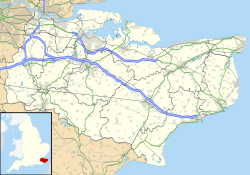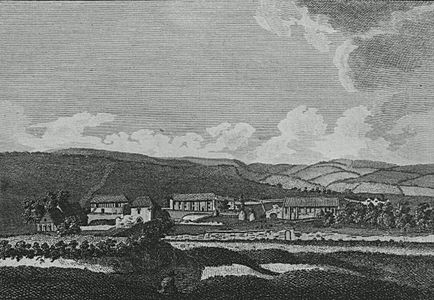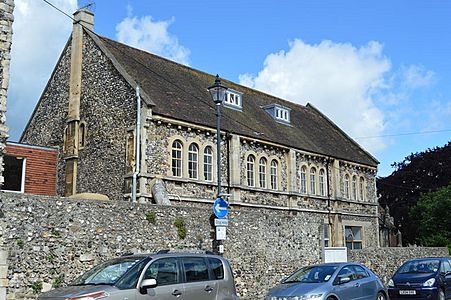Dover Priory facts for kids

Seals of St Martin's Priory and Nunnery
|
|
| Monastery information | |
|---|---|
| Full name | The Priory of St. Mary the Virgin and St. Martin of the New Work, or Newark |
| Established | 1130 |
| Disestablished | 1538 |
| Diocese | Canterbury |
| Site | |
| Coordinates | 51°7′35″N 1°18′24″E / 51.12639°N 1.30667°E |
| Visible remains | Gatehouse, guesthouse, refectory |
| Public access | By permission |
| Other information | Site occupied by Dover College |
Dover Priory was an important priory in Dover, southeast England. It was also known as the Priory of St. Mary the Virgin and St. Martin of the New Work. Over time, it was home to different groups of religious people. First, it was independent, then it housed canons regular following the Augustinian rule. Finally, it became a home for Benedictine monks, connected to Canterbury Cathedral.
The priory was located just east of where Dover Priory railway station is today. The railway was actually built on part of the old priory land. Now, houses stand where the church used to be. Dover College, a private school, uses some of the old medieval buildings. For example, the 12th-century Strangers' Refectory is still used for meals and concerts. The old priory gateway is now a music school, and the guesthouse has become the school's chapel.
Contents
Exploring Dover Priory's Past
Early Beginnings in Saxon Times
Around the early 600s, a group of 22 religious leaders called canons lived near Dover Castle. They might have been connected to the old Saxon church of St Mary de Castro. Later, in the late 600s, King Wihtred moved these canons to a new, smaller church. This church was dedicated to St Martin and was located near what is now Market Square. The canons lived off land and money from the port.
Odo's Influence After the Norman Conquest
After the Normans took over England, the small church at Market Square was given to Odo, Bishop of Bayeux. He rebuilt it much bigger, probably in the same spot. This new, larger church became known as St. Martin's Le Grand. It was built on top of very old Roman bath foundations. Its churchyard covered most of the current Market Square.
Building a New Priory in Dover
The canons at the Castle church had always been special. They answered only to the King and later the Pope, not to the local bishop. The Archbishop of Canterbury, William de Corbeil, wanted to change this. In 1130, he convinced King Henry I to let him move the canons' wealth to a new priory in Dover. The old Market Square church became the main church for the townspeople. The new priory was called "St. Martin's of the New Work" or "Newark" to tell it apart from the parish church.
Building started in 1131 on a new site. Within five years, 12 canons were living there. They dedicated the priory to the Blessed Virgin Mary and St. Martin. Archbishop Theobald finished the buildings around 1140. He also decided that the new priory would follow the Benedictine Rule. It would also be controlled by Canterbury Cathedral. This caused many arguments between the monks of the cathedral and the canons of Dover Priory for the next 200 years.
Life and Challenges from 1150 to 1500
It is said that King Stephen died at the Priory in 1154 while traveling. The priory was damaged by a fire in 1201 and then repaired in 1231. In August 1295, French attackers raided the priory. During this attack, a monk named Thomas de la Hale was killed. Many repairs were made in the 1480s.
The priory's church was very large. A royal official described it as "the fairest church in all that quarter of Kent." It was probably three times bigger than St. Mary's Church in Dover. Its tower would have stood near where Effingham and Saxon Streets meet today. The priory also had impressive cloisters and a refectory (dining hall).
The priory had a wonderful place for writing and a large library. These disappeared when the priory closed. However, parts of the library later reappeared. Some are now in colleges at the University of Cambridge. This includes the Dover Bible, which is one of only six giant Romanesque Bibles still existing.
The Priory Closes Down
In 1538, King Henry VIII closed down Dover Priory as part of the Dissolution of the Monasteries. This was when many monasteries across England were shut down. Records from just before it closed suggest the monks were not very rich. However, they still had some things for visitors.
After the priory closed, local people took stones, lead, and other materials from the buildings. Only two barns, the gate-house, the refectory, and a large hall were left standing. Fishermen later said they used to bring their share of fish to the Priory when it was open. The remaining buildings were used for farming. One building, called the "Priory Barn," often gave shelter to people without homes. This might have been because people remembered that monasteries used to help the poor.
The priory's lands were first given to a religious leader named Richard Thornden. They soon passed to Archbishop Thomas Cranmer. He then leased the lands to others. Some active business people came to Dover to use these lands and other properties from closed religious houses.
Changes in the 18th and 19th Centuries
Pictures from the 1700s and early 1800s show the Priory Farm as a beautiful ruin. It was a pleasant spot on the edge of town. In 1839, a big party was held in the Priory meadow. This was to celebrate the Duke of Wellington becoming the Lord Warden of the Cinque Ports.
Many of the buildings were pulled down in the first half of the 1800s. This included two barns. In 1840, the priory site's owner, a farmer named John Coleman, leased parts of the land for building houses. This damaged the remaining old buildings. Luckily, between 1845 and 1847, a local priest named Dr. F.C. Plumptre carefully recorded everything he could about the old foundations. His work suggests that Effingham Street was built where the dormitory and other parts of the priory once stood.
From about 1840 to 1868, a timber merchant named Steriker Finnis owned or leased the western part of the site. In 1868, the ponds were drained. This area then became Priory Gate Road and part of the yard for Dover Priory railway station.
Dover College: A New Chapter
In 1869, Robert Chignell, who ran a private school, leased part of the Priory buildings. Later, a group of important citizens in Dover took over. They formed the Dover College Company. Their goal was to start a public school on the priory site. They wanted to provide education for local boys and also save the old priory buildings.
Dover College opened in 1871. In 1879, the school acquired the large hall, which had been a guesthouse. They turned it into a chapel for the school. Over time, the school gained ownership of the entire property. The Strangers' Refectory was restored, and an important old painting was found there. The gatehouse was restored in 1881. Many famous people have attended Dover College, including Simon Cowell.








